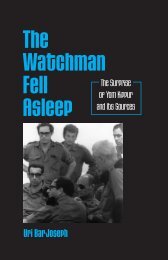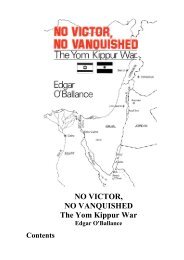israeli fortifications of the october war 1973
israeli fortifications of the october war 1973
israeli fortifications of the october war 1973
You also want an ePaper? Increase the reach of your titles
YUMPU automatically turns print PDFs into web optimized ePapers that Google loves.
The Bar Lev Line was named<br />
after <strong>the</strong> contemporary Chief<br />
<strong>of</strong> Staff <strong>of</strong><strong>the</strong> IOF (1968-71),<br />
Lieutenant-General Haim Bar<br />
Lev, shown here during <strong>the</strong><br />
Yom Kippur War when he<br />
assumed overall control <strong>of</strong><br />
Sou<strong>the</strong>rn Command after<br />
<strong>the</strong> failure <strong>of</strong> its GOC,<br />
Major-General Shmuel Gonen,<br />
in <strong>the</strong> opening days <strong>of</strong> <strong>the</strong> <strong>war</strong>.<br />
General Bar Lev confers on <strong>the</strong><br />
telephone in <strong>the</strong> IOF <strong>war</strong> room<br />
deep underground in <strong>the</strong><br />
bowels <strong>of</strong> <strong>the</strong> Kiryah in Tel Aviv<br />
on 19 October <strong>1973</strong> with <strong>the</strong><br />
situation map behind him<br />
showing <strong>the</strong> expanding IOF<br />
bridgehead across <strong>the</strong> Suez<br />
Canal and <strong>the</strong> impending<br />
breakout south<strong>war</strong>ds to<br />
encircle <strong>the</strong> Egyptian<br />
Third Army. Fur<strong>the</strong>rmore, <strong>the</strong> Egyptian armed forces now enjoyed an absolute majority<br />
in numbers <strong>of</strong> AFVs and artillery pieces, as well as a massive preponderance<br />
<strong>of</strong> manpower. The creation <strong>of</strong> <strong>the</strong> Bar Lev Line and its tacit admission <strong>of</strong> a<br />
static linear defence played into <strong>the</strong> hands <strong>of</strong> Egyptian material superiority.<br />
High Israeli casualties along <strong>the</strong> Suez Canal would have a debilitating effect<br />
on Israeli public opinion, while mobilizing <strong>the</strong> reserves to counter a protracted<br />
Egyptian <strong>of</strong>fensive would significantly damage <strong>the</strong> Israeli economy. Politically,<br />
<strong>the</strong> Egyptians saw <strong>the</strong> line as an attempt to ensure <strong>the</strong> continuation <strong>of</strong> <strong>the</strong><br />
military status quo and <strong>the</strong> definition <strong>of</strong> <strong>the</strong> Suez Canal as <strong>the</strong> de facto border<br />
between Israel and Egypt. This was utterly unacceptable. On 3 March 1969,<br />
President Nasser announced that <strong>the</strong> ceasefire agreement <strong>of</strong> June 1967 with<br />
Israel was null and void. Five days later, <strong>the</strong> Egyptians launched a massive<br />
bombardment along <strong>the</strong> Suez Canal that was to last almost 80 days without<br />
ceasing. The War <strong>of</strong> Attrition was resumed in earnest.<br />
Boredom was a constant<br />
enemy to <strong>the</strong> troops stationed<br />
on <strong>the</strong> Bar Lev Line so anyone<br />
with musical skills was always<br />
a welcome addition to any<br />
unit, such as <strong>the</strong>se soldiers<br />
relaxing in <strong>the</strong>ir sleeping and<br />
living quarters at Maoz Milano.<br />
These tubular steel structures<br />
were immensely strong but<br />
also c1austrophobically<br />
cramped with hardly room<br />
to stand upright.<br />
24<br />
Day after day artillery shells impacted on <strong>the</strong> newly constructed<br />
<strong>fortifications</strong>. None were penetrated or put out <strong>of</strong> action although some<br />
suffered serious damage. The armoured reserves were able to advance to <strong>the</strong>ir<br />
firing ramps and engage <strong>the</strong> Egyptian positions according to plan. The<br />
self-propelled artillery units were able to roam <strong>the</strong> front in response to <strong>the</strong> fire<br />
direction from <strong>the</strong> observation posts along <strong>the</strong> canal while <strong>the</strong> IAF maintained<br />
air superiority over <strong>the</strong> battlefield. The Navy continued to dominate <strong>the</strong><br />
extensive coastline <strong>of</strong> <strong>the</strong> Sinai Peninsula against Egyptian incursion.<br />
Casualties were light and mainly among <strong>the</strong> exposed crews <strong>of</strong> <strong>the</strong> artillery<br />
weapons. The concept <strong>of</strong> <strong>the</strong> Bar Lev Line seemed to be working, although<br />
some strongpoints were incomplete when hostilities were renewed leaving<br />
significant stretches without observation.<br />
THE PURPLE LINE<br />
Arguably, <strong>the</strong> IDF victory on <strong>the</strong> Golan Heights in <strong>the</strong> closing hours <strong>of</strong> <strong>the</strong><br />
Six Day War was <strong>of</strong> greater significance than that in <strong>the</strong> Sinai Peninsula. The<br />
towns and villages near <strong>the</strong> Sea <strong>of</strong> Galilee below <strong>the</strong> Golan escarpment were<br />
now safe from Syrian artillery fire while <strong>the</strong> vital head waters <strong>of</strong> <strong>the</strong> Jordan<br />
River were in Israeli hands: as was <strong>the</strong> dominating feature <strong>of</strong> Mount Hermon<br />
II FOLLOWING PAGE: MACHINE-GUN BUNKER<br />
Fundamental to <strong>the</strong> construction <strong>of</strong> <strong>the</strong> Bar Lev Line was<br />
<strong>the</strong> widespread use <strong>of</strong> prefabricated components that were<br />
made in Israel and transported to <strong>the</strong> Suez Canal. A typical<br />
machine-gun emplacement comprised a steel shell with integral<br />
firing slits. Steel railway ties usually in two layers protected <strong>the</strong><br />
ro<strong>of</strong> <strong>of</strong> <strong>the</strong> shell. These supported a layer <strong>of</strong> interlocking<br />
concrete blocks above which were rock gabions as <strong>the</strong> final<br />
level <strong>of</strong> protection against artillery fire. All sides <strong>of</strong> <strong>the</strong> steel<br />
shell were lined with <strong>the</strong> standard concrete blocks that had<br />
lifting holes in <strong>the</strong>ir sides and four holes through <strong>the</strong> top and<br />
Women have always been an<br />
integral part <strong>of</strong> <strong>the</strong> IOF and<br />
<strong>the</strong>y perform many important<br />
support roles. Here, a corporal<br />
telephonist named Fanny<br />
hangs out her washing on <strong>the</strong><br />
Bar Lev Line or more exactly<br />
at <strong>the</strong> Sou<strong>the</strong>rn Command<br />
headquarters complex at<br />
Refidim that controlled all<br />
<strong>the</strong> Maozim.<br />
bottom faces. Through <strong>the</strong>se were slotted steel 'rebar'<br />
(reinforcing bars) to streng<strong>the</strong>n <strong>the</strong> whole structure. The<br />
outsides were <strong>the</strong>n lined with yet more rock gabions. Ano<strong>the</strong>r<br />
prefabricated item was <strong>the</strong> concrete funnel that was aligned<br />
with <strong>the</strong> firing slits <strong>of</strong> <strong>the</strong> weapons. An emplacement<br />
commonly had up to three firing slits but <strong>the</strong> number used<br />
was dependent on <strong>the</strong> terrain and <strong>the</strong> fields <strong>of</strong> fire covered<br />
by <strong>the</strong> position. This method <strong>of</strong> construction was typical for<br />
many weapons emplacements and o<strong>the</strong>r structures such<br />
as observation posts.




